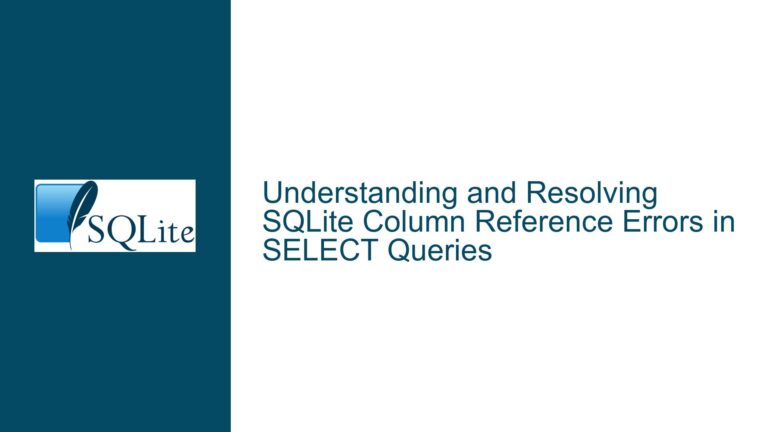Optimizing SQLite Queries for Large-Scale Enumerated Data Retrieval
Issue Overview: Retrieving Ordered Enumerated Symbols Efficiently
The core issue revolves around efficiently retrieving and ordering enumerated symbols from a large SQLite table. The table schema is designed to track enumerated values for each symbol, with the name field representing a low-cardinality category and the symbol field representing a high-cardinality identifier. The idx field, managed by an AFTER trigger, is used to maintain insertion order, though its relevance to the query performance is minimal. The primary challenge is to retrieve the list of symbols for each name in insertion order, which is critical for in-memory interning in the client application.
The table schema is as follows:
CREATE TABLE enums(
name TEXT,
symbol TEXT,
idx INTEGER,
created_at DATETIME DEFAULT (unixepoch(CURRENT_TIMESTAMP)),
PRIMARY KEY (name, symbol)
);
The straightforward approach to retrieve the data is:
SELECT name, symbol FROM enums ORDER BY ROWID;
This query retrieves all rows in insertion order, which is determined by the ROWID. However, this approach may involve a large number of SQLite API calls, especially when dealing with millions of rows. To mitigate this, alternative approaches using GROUP_CONCAT and batching were proposed:
SELECT name, group_concat(symbol, char(31)) FROM enums GROUP BY name ORDER BY ROWID;
and
SELECT name, floor(idx/100000) AS batch, group_concat(symbol, char(31)) AS syms FROM enums GROUP BY name, batch ORDER BY ROWID;
These approaches aim to reduce the number of API calls by concatenating symbols into a single string per name or batch, respectively. However, concerns were raised about the efficiency and correctness of these methods, particularly regarding the ordering of concatenated symbols and the overhead of processing large strings in the application.
Possible Causes: Performance Bottlenecks and Ordering Ambiguities
The primary performance bottleneck in this scenario is the sheer volume of data being processed. With hundreds of millions of rows, even small inefficiencies in query execution or data retrieval can lead to significant performance degradation. The following factors contribute to the issue:
High Cardinality of Symbols: The
symbolfield has a very high cardinality, meaning there are hundreds of millions of unique values. This results in a large number of rows being processed, which can slow down query execution and increase memory usage.Ordering by ROWID: While ordering by
ROWIDensures that the results are returned in insertion order, it may not be the most efficient approach for large datasets. TheROWIDis an internal identifier used by SQLite, and accessing it requires additional overhead, especially when dealing with large tables.Group Concatenation Overhead: Using
GROUP_CONCATto concatenate symbols into a single string pernameor batch introduces additional processing overhead. The concatenation operation must be performed for each group, and the resulting string can be very large, leading to increased memory usage and potential performance issues when splitting the string in the application.Ambiguity in Group Concatenation Ordering: The order of symbols within the concatenated string is not guaranteed unless explicitly specified. This can lead to inconsistencies in the results, especially if the query planner decides to traverse the rows in a different order than expected.
Application-Level Processing: The efficiency of the application-level processing of the retrieved data can also impact overall performance. If the application is not optimized for handling large datasets, the overhead of processing each row individually can outweigh the benefits of reducing the number of API calls.
Troubleshooting Steps, Solutions & Fixes: Optimizing Data Retrieval and Processing
To address the issues outlined above, several strategies can be employed to optimize data retrieval and processing. These strategies focus on reducing the number of API calls, ensuring correct ordering of results, and minimizing the overhead of processing large datasets.
1. Optimize Query Execution with Explicit Ordering
To ensure that the symbols are retrieved in the correct order, it is essential to explicitly specify the ordering in the query. This can be achieved by using a subquery to enforce the desired order before applying GROUP_CONCAT. For example:
SELECT name,
(
SELECT group_concat(symbol, char(31))
FROM (
SELECT symbol
FROM enums
WHERE name == o.name
ORDER BY ROWID
)
) AS symbols
FROM (
SELECT DISTINCT name
FROM enums
ORDER BY ROWID
) AS o;
This query ensures that the symbols are concatenated in ROWID order within each group, while the groups themselves are returned in ROWID order. This approach eliminates any ambiguity in the ordering of symbols and ensures consistent results.
2. Batch Retrieval for Large Datasets
For very large datasets, retrieving all rows in a single query may not be feasible due to memory constraints. In such cases, batching can be used to retrieve the data in smaller chunks. This can be achieved by dividing the idx field into batches and retrieving each batch separately:
SELECT name, floor(idx/100000) AS batch, group_concat(symbol, char(31)) AS syms
FROM enums
GROUP BY name, batch
ORDER BY ROWID;
This query retrieves the symbols in batches of 100,000, reducing the memory footprint of each query and allowing the application to process the data incrementally. However, care must be taken to ensure that the batches are processed in the correct order to maintain the overall insertion order.
3. Leverage Indexes for Faster Retrieval
Indexes can significantly improve query performance by reducing the number of rows that need to be scanned. In this case, an index on the name and ROWID fields can help speed up the retrieval of symbols for each name:
CREATE INDEX idx_enums_name_rowid ON enums(name, ROWID);
This index allows SQLite to quickly locate the rows for each name and retrieve them in ROWID order, reducing the overall query execution time.
4. Evaluate the Use of SQLite for Large Datasets
While SQLite is a powerful and lightweight database, it may not be the best choice for extremely large datasets with hundreds of millions of rows. In such cases, a more robust database system designed for high scalability, such as PostgreSQL or MySQL, may be more appropriate. These databases offer advanced indexing, partitioning, and parallel processing capabilities that can handle large datasets more efficiently.
However, if SQLite is the preferred choice due to its simplicity and ease of use, it is essential to optimize the schema and queries to minimize performance bottlenecks. This includes using appropriate indexes, batching, and efficient query execution strategies.
5. Optimize Application-Level Processing
The efficiency of the application-level processing of the retrieved data can have a significant impact on overall performance. To minimize overhead, the application should be optimized for handling large datasets. This includes:
Efficient Data Structures: Use efficient data structures, such as hash maps or arrays, to store and process the retrieved data. This can reduce the time complexity of operations such as insertion and retrieval.
Parallel Processing: If the application supports parallel processing, consider processing multiple batches of data concurrently. This can significantly reduce the overall processing time, especially for large datasets.
Memory Management: Ensure that the application manages memory efficiently, especially when dealing with large strings or data structures. This includes freeing up memory when it is no longer needed and avoiding memory leaks.
6. Benchmark and Compare Different Approaches
To determine the most efficient approach, it is essential to benchmark and compare the performance of different query strategies. This includes measuring the execution time, memory usage, and overall performance of each approach under realistic conditions. The following Python script provides an example of how to benchmark different query strategies:
import collections
import sqlite3
import time
import random
import os
from collections import defaultdict
from random import randint
if os.path.isfile('test.db'):
os.unlink('test.db')
db = sqlite3.connect('test.db', isolation_level=None)
# Build our database
nNames = 100
nSymbol = 100000
nRows = 5000000
rs = chr(30)
fs = chr(31)
print(f"nNames = {nNames}; nSymbol = {nSymbol}; nRows = {nRows}")
ascii = list(c for c in 'ABCDEFGHIJKLMNOPQRSTUVWXYZ')
def randomlist(size):
from random import shuffle
a = []
for i in range(size):
shuffle(ascii)
a.append(''.join(ascii[:8]))
return a
st = time.time()
nameList = randomlist(nNames)
symbolList = randomlist(nSymbol)
print(f"Random lists created in {round(time.time()-st,3)} seconds")
db.executescript("CREATE TABLE enum(name TEXT NOT NULL, symbol TEXT NOT NULL, PRIMARY KEY(name, symbol))")
st = time.time()
lNames = nNames - 1
lSymbols = nSymbol - 1
db.executescript('BEGIN')
for i in range(nRows):
db.execute('INSERT OR IGNORE INTO enum VALUES (?,?)', (nameList[randint(0, lNames)], symbolList[randint(0, lSymbols)]))
db.execute('COMMIT')
print(f"Database Build Complete; {nRows} in {round(time.time()-st,3)} seconds")
print(f"Table enum contains {db.execute('SELECT COUNT() FROM enum').fetchone()[0]} rows")
print()
# Retrieve the data one by each and build an in-memory structure
print("Building internal data structure method simple")
sql = """
SELECT name, symbol
FROM enum
ORDER BY ROWID
"""
data = None
st = time.time()
data = defaultdict(list)
for row in db.execute(sql):
data[row[0]].append(row[1])
for key in data.keys():
data[key] = tuple(data[key])
print(f"Internal Structure built in {round(time.time()-st, 3)} seconds")
print()
data = None
# Retrieve the data in "diddled" form
print("Building internal data structure diddling the data so there is one row per name")
sql = """
SELECT name,
(
SELECT group_concat(symbol, char(31))
FROM (
SELECT symbol
FROM enum
WHERE name == o.name
ORDER BY ROWID
)
) AS symbols
FROM (
SELECT DISTINCT name
FROM enum
ORDER BY ROWID
) AS o
"""
data = {}
st = time.time()
for row in db.execute(sql):
data[row[0]] = tuple(row[1].split(fs))
print(f"Internal Structure built in {round(time.time()-st, 3)} seconds")
print()
This script builds a large dataset, retrieves the data using two different approaches, and measures the time taken to build the in-memory data structure. The results can be used to compare the performance of each approach and determine the most efficient strategy for the specific use case.
7. Consider Alternative Database Solutions
If the dataset size continues to grow and SQLite’s performance becomes a limiting factor, it may be necessary to consider alternative database solutions. Some options include:
PostgreSQL: A powerful, open-source relational database system that offers advanced features such as partitioning, parallel query execution, and extensive indexing options. PostgreSQL is well-suited for large datasets and can handle high levels of concurrency.
MySQL: Another popular open-source relational database system that offers good performance and scalability. MySQL is widely used in web applications and can handle large datasets efficiently.
NoSQL Databases: For extremely large datasets or unstructured data, NoSQL databases such as MongoDB or Cassandra may be more appropriate. These databases are designed for high scalability and can handle large volumes of data with ease.
When considering alternative database solutions, it is essential to evaluate the specific requirements of the application, including data size, query complexity, and performance needs. Additionally, the migration process should be carefully planned to ensure data integrity and minimize downtime.
Conclusion
Efficiently retrieving and processing large-scale enumerated data in SQLite requires careful consideration of query optimization, indexing, and application-level processing. By explicitly specifying the ordering in queries, leveraging indexes, and optimizing application-level processing, it is possible to achieve significant performance improvements. Additionally, benchmarking different approaches and considering alternative database solutions can help ensure that the application can handle the growing data size and complexity. With these strategies in place, SQLite can be a viable option for managing large datasets, even in high-performance applications.






